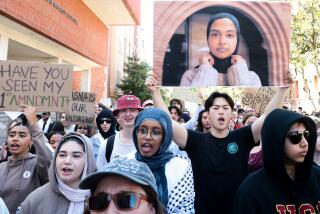Race of Compton Suspect Startles Police
Except for the victim’s ties to a famous family, the killing of Yetunde Price was distressingly typical for Compton, a late-night gang shooting with witnesses telling conflicting accounts.
But the arrest of suspect Aaron Hammer, 24, handed investigators a rare surprise: Hammer is white.
The detail was at once trivial and striking. Price, the half sister of tennis stars Venus and Serena Williams, was the victim of gang violence, police said. Hammer is believed to be an associate of the black Crips gang, police said, but his race appears to have no bearing in the case.
Still, a white associate of the Crips is so unusual in Compton that seasoned investigators did double takes.
“You don’t get this,” said Los Angeles County Sheriff’s Capt. Frank Merriman, head of homicide. He said he knew of only one other case in his 35-year career in which a non-Latino white had been linked in this way to a black gang.
“It was shocking to me,” said Capt. Cecil Rhambo, head of the sheriff’s Compton station, who grew up in South Los Angeles.
Such reactions speak to the racial segregation in Los Angeles County, and the corresponding segregation of crime. Compton is a black and brown city. Non-Latino whites make up only about 1% of the population. Gang members also are overwhelmingly African American and Latino.
Day in and day out, police confront an almost uniformly black and Latino world of victims and perpetrators in which gang affiliations follow predictable ethnic patterns. They almost never see suspects the color of “White Boy Aaron” -- Hammer’s nickname in his Compton neighborhood.
In interviews, Hammer’s acquaintances and family members said race had influenced his life in ways that went beyond the nickname. Some said that growing up white in a black neighborhood molded his choices, perhaps prompting him to try harder to fit in.
At the same time, though, their accounts highlighted ways in which race didn’t seem to matter -- or at least mattered less than neighborhood conditions in shaping Hammer’s life. The descriptions by friends and family members suggest that Hammer’s connections to gangs had been woven of the same threads of geography and peer pressure as those of young black men commonly linked by police to gangs.
In the end, Hammer’s race seemed to recede behind personal troubles, bad choices, brushes with the law and his desire “to kick it” with a tough but familiar crowd.
Hammer was charged Sept. 16 in the killing of Price, a 31-year-old mother of three outside a suspected drug house in south Compton early Sept. 14. His arraignment was scheduled for Tuesday. He was being held without bail at Twin Towers jail.
Detectives allege that Hammer and others opened fire from the frontyard at Price, a passenger in a white SUV. Merriman said investigators now believe that Price and her companion might have been just driving by, contrary to earlier reports that an argument had preceded the shooting.
Price has been described by friends and family as a devoted mother who co-owned a beauty salon and worked as a nurse. She had moved to a new house in Corona last year. Her death, one among several hundred homicide deaths in Los Angeles County so far this year, has sparked protests and drawn national attention to Compton.
Implicated in the crime, police said, are the Southside Crips, a long-standing Compton gang of about 150 members, nearly all black.
The racial makeup of Los Angeles County street gangs is reinforced by the culture of prisons, in which inmates commonly divide themselves along color lines, Rhambo said -- blacks with blacks, Latinos with Latinos. When whites enter the mix on the streets, Rhambo said, it’s more common to see them join Latino gangs.
Exactly how closely Hammer was tied to the Crips is unclear. Lt. Dan Rosenberg, who is overseeing the homicide investigation, played down the connection. “I believe he may have been hanging out with them,” he said. “I don’t know if he was an active gang member.”
His comments reflect one law enforcement view that gang membership can be ambiguous. Between those men identified by police as hard-core gang members and those called associates lies a “significant gray area,” Rhambo said. On the edges of gangs are people who are related to gang members, or who have been intimidated or coerced into cooperating.
There are also those who have left the gang, or who simply spend time with members. “You may hang out with them, but you may not caper with them, or even drink with them,” Rhambo said. “But then the cops pick you up with them ... and you are lumped in.”
“It’s possible,” Rosenberg said, that Hammer “just hangs out with the fellas.”
Acquaintances of Hammer voiced similar thoughts. Rogelio Alberto Tovar, 22, who is friends with many Southside Crips, said Hammer could never have been a true member of the traditionally black gang because he is white. Compton resident Ramon Sanders, who met Hammer two years ago, agreed.
“I think he kicked it with Southside,” Sanders said, but he didn’t think Hammer was a member. “He just hung with them.”
One friend, Rayshell Lee, disputed Hammer’s alleged gang ties, saying that everyone who grows up in South Compton is going to end up being friendly with gang members.
“You’re in Compton, and that’s what’s here,” she said.
Hammer, 24, spent most of his life in the neighborhoods close to the crime scene. His grandparents left North Dakota for California in the 1950s, looking for better jobs and an escape from bitter winters. Two of their children, Hammer’s uncle Dale Nelson and Hammer’s mother Doreen Hammer, moved from the Lakewood-Bellflower area to an affordable house on Tichenor Street in Compton in 1980 when Aaron Hammer was about a year old. Hammer’s father did not live with the family, the uncle said.
Compton had undergone swift racial change, and would change again after they arrived. The once-white city shifted to mostly black decades ago. A Latino shift followed. In 1980, according to one UCLA study, blacks were 74% of Compton’s population, whites 3%. But by 1990, Compton’s black population had dropped to 40% of the total, and the white population had nearly disappeared. A solid majority of the city’s population had become Latino.
Nelson, a disabled former manager of an auto parts store, said he had no qualms about moving to a city that so many other whites had already abandoned. The house was affordable and in good shape, he said, and a black fishing buddy who owns a property next door had spoken highly of the neighborhood.
“We’ve never had a racial problem with anybody,” said Nelson, who bought the house with Hammer’s mother. “People can get along, you know.” The 1200 block of East Tichenor Street is lined with modest mid-century bungalows neatly painted in baby blues and delicate pinks. On a recent afternoon, mothers watered green unfenced yards, and fathers greeted one another on their way home from work. Youngsters tossed a football in the street.
Nathaniel Harris, a 78-year-old neighbor, remembered seeing Hammer as a boy being rejected by a group of children playing basketball. He won them over by bringing drinks from his house.
“Of course, being on this street and being the only white kid made it hard, so, yeah, he did a little more to fit in,” said Shon Anthony, 25, who also grew up on Tichenor Street. “He was an outgoing kid. Not too mischievous .... He wasn’t the alpha male,” but he wasn’t getting beaten up constantly either.
Other black neighbors said Hammer had been easily accepted. He joined neighbors Rayshell and Shoshona Lee on trips to their predominantly black church, carved their Thanksgiving turkeys, and accompanied them on vacations.
Hammer was diagnosed with attention-deficit disorder as a child, and Nelson said Hammer’s mother had been afraid her son wasn’t receiving enough attention at the local junior high school. Hammer transferred, and later graduated from Mayfair High School in Lakewood, which has a larger percentage of white students than Compton schools.
Hammer never strayed far from his roots. He never got a driver’s license, which kept him close to home. He raised pigeons in a backyard shed and sold CDs out of his backpack. He moved easily in his neighborhood circles, speaking the street slang he had grown up with, and picking up credible skills as a street-corner rapper.
Pastor Robert Smith recalled Hammer’s involvements in the three-on-three basketball tournaments at Calvary Baptist Church. “He was a pretty decent player,” Smith said. “You could tell he’d been playin’ with the brothers all his life.”
Nelson said Hammer was also having trouble holding down jobs, though he did work briefly at a couple of auto parts stores. Nelson said Hammer’s mother died of a heart attack four years ago.
As Hammer grew older, Pastor Smith and others noticed that Hammer was hanging around a pretty tough crowd -- always more of a follower than a leader, Smith said.
Smith said he thought the company might “bring him down. But then again, that’s who he was raised up with.”
Young men are commonly challenged in neighborhoods where gang members wield power. Race could have made Hammer stand out all the more, Rhambo said. “You can’t be neutral if you are white,” he said.
“Typically when you have a white person in an area like this, it’s sink or swim. You are predator or prey,” Rhambo said. “Somebody is going to do something to you, somebody is going to try to intimidate you.”
In January 1999, Hammer pleaded no contest to a second-degree burglary charge. He was sentenced to serve 85 days in County Jail and three years’ probation. About 10 months later, he was charged with writing bad checks and burglary, records show, and pleaded no contest on the burglary.
In May 2000, he was arrested at a Sears store in Burbank. Hammer had tried to buy merchandise with a phony credit card, according to court documents. He had entered the store with a companion, a young black man, court documents said, but only Hammer was arrested.
The officers described their black-haired, brown-eyed, 260-pound suspect as Latino. He was carrying a fake driver’s license bearing the name Diaz.
Upon arrest, he pleaded with officers for medication for ADD, and then told them about his mother’s death, court documents said.
He added that he had been, “hanging around with the wrong crowd.”
*
Times staff writer Richard Winton contributed to this report.
More to Read
Start your day right
Sign up for Essential California for news, features and recommendations from the L.A. Times and beyond in your inbox six days a week.
You may occasionally receive promotional content from the Los Angeles Times.






